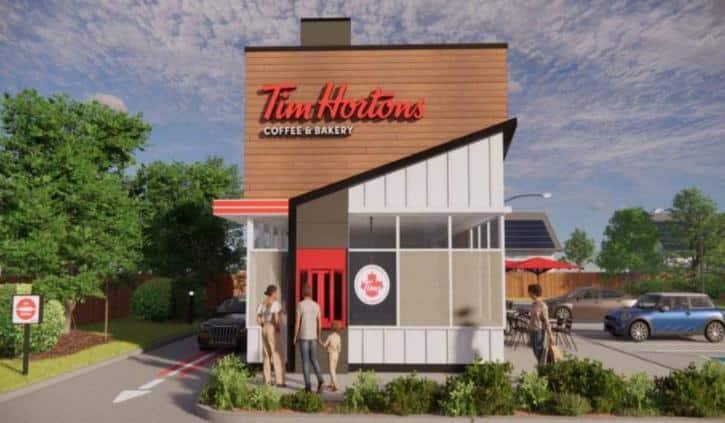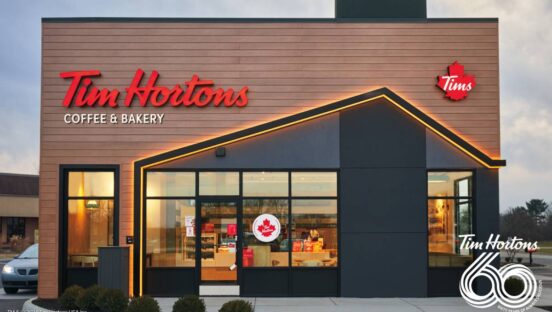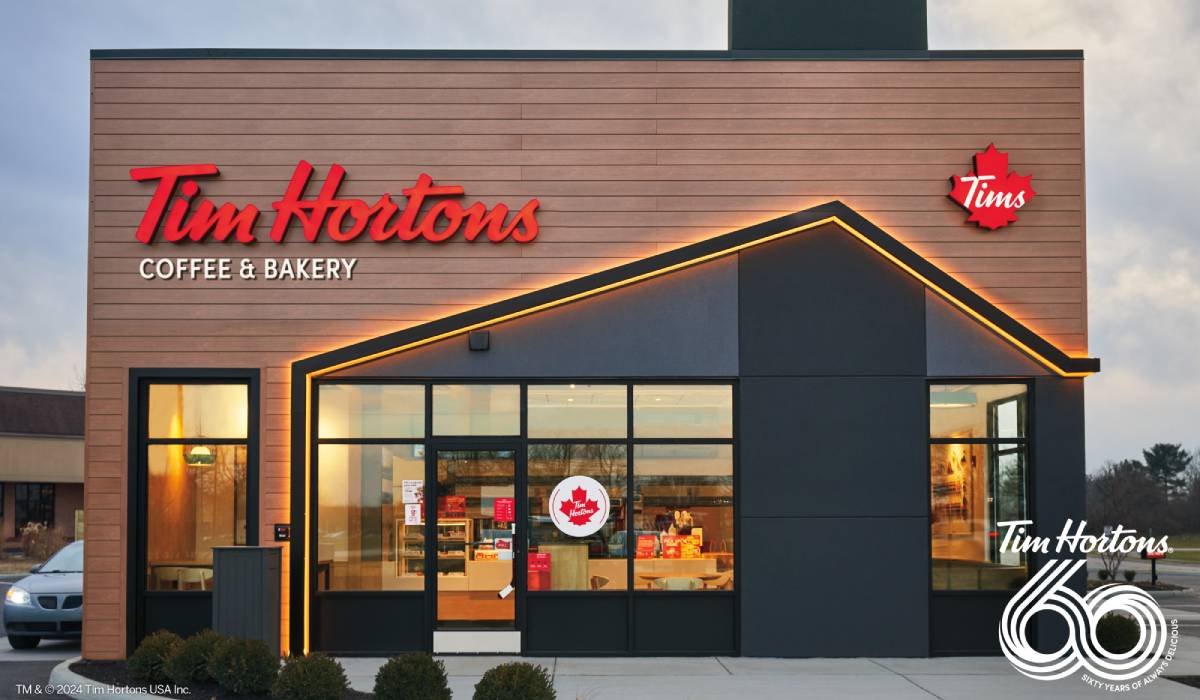Emerging from the pandemic haze, the beverage sector has been home to some of the industry’s clearest growth stories. Starbucks’ U.S. pace in 2022 was unrivaled at 429 net units. Dunkin’ widened by 126 and Dutch Bros 133. That meant three of the top 10 fastest-growing restaurants in America (sorted by those in the top 50 by systemwide sales) owed to beverage-focused chains. Starbucks, meanwhile, believes it will reach 55,000 total shops by 2030 and Dutch Bros has plans for 1,000 by 2025. Just the cold coffee sector alone is expected to grow by 22 percent each year for the next three. According to Euromonitor, “chained cafes” are pacing toward a compounded annual rate of 10.5 percent.
During this run, it’s also fair to say beverages, coffee in particular, began to fill a different needset for consumers. Occasions slid later in the day and the label of coffee as an “affordable luxury” became an accepted price and innovation reality.
That forming gap, however, is exactly where Tim Hortons wants to reintroduce itself to U.S. guests.
This year marks the 60th in the Canadian icon’s history. It’s also the 40th since Tim Hortons launched stateside in 1984 in Tonawanda, New York, at the northern edge of Erie County.
While the brand ended 2022 with 636 domestic restaurants, those four decades have never quite seen Tim Hortons grab share in the way the brand is accustomed to north of the border. In Canada, there are few—if any—more ubiquitous retail names. There’s roughly a Tim Hortons for every 10,000 residents (the most recent unit count in the country was 3,874). For comparison, there’s one McDonald’s for every 25,000 people in the U.S.
And from a frequency standpoint, Tim Hortons said in the past 80 percent of Canadians visit the brand every month. That’s the same percentage of Americans who go to McDonald’s—each year. Tim Hortons’ loyalty program in Canada boasts north of 5 million average monthly active users, more than Uber Eats. Back in 2022, Tim Hortons, by average days active per user, was well ahead of the aggregator at 23.9 versus 15.5. Simply, it was the largest food beverage loyalty program in all of Canada.
These statistics are more than restaurant trivia night fodder, says Tim Hortons U.S. president Katerina Glyptis, who stepped into the role over the summer after nine years at RBI, including a most recent post at VP of franchise operations overseeing 7,200 Burger Kings.
Firstly, they tell a story Tim Hortons has understood for years: Its awareness far outsizes its domestic unit count. But perhaps more pressing in the current picture, there is clearly a space Tim Hortons can fill in guests’ lives, Glyptis says, the brand has an unparalleled track record in. “We think of ourselves as part of people’s lives and part of people’s routines,” she says. “Not as a one-off luxury, but part of their every day, every week. People coming in the morning before work. People dropping their kids off at school. People coming back at the end of the day or picking family up from soccer practices. That’s where we see ourselves.”
“And because of our affordable, attractive, everyday price point,” Glyptis adds, “we can fit into people’s lives in a way that, in this environment, I think is not the case for all concepts and brands.”
Tim Hortons ended 2023 with its largest number of U.S. restaurant openings in over five years, including expansion into new markets such as Texas and Georgia. Additionally, it finalized agreements with operators to open in Arizona, Tennessee, Missouri, Delaware, and New Jersey.
Tim Hortons lost 23 U.S. stores during COVID-saddled 2022 before expanding by four in 2021 and retracting by one unit in 2022.
Glyptis has personally experienced a well-worn story of life in the early stages of leading a legacy chain. A Cleveland native, she says customers and operators ask, “when is Tim Hortons coming to my hometown?” enough to fill a request jar full of change.
Yet it’s a more vivid point here than normal. Headed into 2023, Indiana, Kentucky, Maine, New Jersey, and Texas all had 10 or fewer Tim Hortons (West Virginia had 11). Of the brand’s 636 restaurants, 245 were in New York, with many congregated close to its Canadian roots. Michigan had another 205 and Ohio 134. Pennsylvania housed 20 Tim Hortons.
It’s an uncomplicated vision in terms of greenspace, Glyptis says, and the reason RBI has recently infused added resources into the brand, namely on the leadership side, to begin tackling some of it. Put plainly, the whole country is wide open.
But what’s changed from prior efforts? To start, in 2021 the brand introduced two new prototypes—a 900-square-foot drive-thru-only model and a 1,600-square-foot restaurant with 24 seats. The typical freestanding shops are roughly 2,000–2,300 square feet.

Tim Hortons calls this the “Welcome 2021 image” in filings. Total standard Tim Hortons in 2021–2022 reported same-store sales growth of 0.4 percent. The new model shops, of which six counted, were at 7.3 percent. These posted average gross monthly sales of $85,679. One was at $113,111. The overall 2022 store number, including the new model stores, was an average of $93,090.
These updated builds arrive with lower CapEx and a better payback period for operators. “It’s kind of the sweet spot that we’ve found,” Glyptis says. “And we have streamlined the menu accordingly as well to really refocus on a lot of our guests’ favorites, a lot of the top sellers. And, again, they have really good efficiency to make things easier for our team members, make things faster and quicker, and also ensure more accuracy for our guests. All the while, they make things significantly more affordable and attractive of an investment for new franchisees.”
Ryan Ferranti, Tim Hortons’ head of business development and franchising, is also relatively new to his title. He came over full-time in January 2023 after two years as director and head of franchising at sister brand Popeyes. Before, he was a franchise business partner and senior manager at Burger King.
Ferranti says, as RBI’s other restaurant brands could attest, the arrival of former Domino’s CEO Patrick Doyle as executive chairman in late 2022 included a playbook obsessed with franchisee profitability. By 2018, the average profit per store for franchise owners at Domino’s grew from $49,000 a year to more than $136,000. Stock climbed from $12 when Doyle started to roughly $270 as he exited—an eight-year run that saw particular improvements to ingredient quality and menu focus.
In that profitability sphere, Ferranti says, is where Tim Hortons’ format evolution began. Keep the cost of construction down and improve flexibility in models so the pipeline can grow. While the drive-thru-only format has a place in Tim Hortons’ future, he says, the 1,600-square-foot building is going to the bread and butter. “In our core markets, existing markets, franchisees are opting for this format as well,” Ferranti says. “In our new markets to the South, same thing. Much better payback, smaller footprint, less square footage needed.”
That said, the larger option isn’t out of play. The broader observation, Ferranti adds, is the dining room continues to prove important—even when smaller than it used to be—to the Tim Hortons’ guest profile.
It’s a learning that returns to Glyptis’ earlier comments. The community aspect of Tim Hortons and its everyday vibe is a separator worth nurturing. Couple that with a more ROI friendly franchise option and there’s ample growth to chase, she says.
Glyptis adds Tim Hortons takes it “very seriously” that customers show up three, four, five days a week. “That’s a huge responsibility that we appreciate being entrusted with,” she says. Employees are often the first person somebody sees in their daily routine outside of the house. “It’s so important that’s a good, positive experience,” Glyptis says.
Over 40 years, Tim Hortons’ U.S. footprint has grown through local, often smaller operators, as evidenced by the low restaurant counts in so many states. “I am always surprised, but love hearing, how our team members recognize people’s voices in the drive-thru,” she says. “Sometimes just by the way the car sounds when they pull up. They know who it is and what they’re about to order because of this often-daily relationship.”
“Part of that is pricing,” Glyptis continues. “Part of that is overall experience. Part is the guest connection that I think our restaurant teams facilitate with guests who come all the time.”
Akin to the Canadian side, technology is helping Tim Hortons connect its mission to the consumer at the store level. Loyalty users account for more than 30 percent of sales in Canada (the brand posted systemwide sales of $1.737 billion there in Q3). And similarly, the aim has been to use personalized and targeted offers to raise frequency. For instance, Tim Hortons in Canada pulsed deals to try p.m. snacks. More than 65 percent of the brand’s new “Dream Cookie” sales came in the p.m. daypart last quarter, nearly 5 percent higher than p.m. sales for Tim Hortons’ core cookie offerings. Overall, adding in the impact of expanded savory, anytime snackers with the introduction of twists, Tim Hortons witnessed 7 percent, year-over-year, growth in p.m. food sales.
In honor of its 60th anniversary, the U.S. business offered two classic Tims Retro Donuts—Walnut Crunch and Cinnamon Twist—for a limited time. Then, it enabled rewards members to access Free Coffee Mondays with a $2 purchase. Users also earn 2X the points all January when ordering or scanning using the Tims App or a Tims Rewards card.
Alongside generating visits, though, Glyptis says technology is working to loop together the prevailing theme at Tim Hortons—to make it easier for frequent users to make the brand part of their routines. One sizable change was the addition of scan and pay where customers can pick up and checkout, while also earning loyalty points, by using their mobile devices to scan QR codes versus paying with a card or cash. Glyptis says it’s created a more seamless experience for employees and guests, and driven better throughput.
On the company’s Q3 earnings, RBI CEO Josh Kobza said “proactive operational initiatives,” like scan and pay adoption, as well as coast-to-coast speed of service trainings and an improved labor climate, helped lead to a 7 percent, year-over-year jump in guest satisfaction and nearly 10 percent better drive-thru speed of service compared to the prior-year period.

Go West (and More)
Ferranti says to expect Tim Hortons to continue heading West. When he joined the company, he recalls, much of the development grid was adjacent to brand strongholds; places where affinity for Tim Hortons was clear and established. But what the brand has come to realize is, it doesn’t have an awareness quandary.
So markets like Texas and Georgia are stocked with customers familiar with Tim Hortons, whether they experienced it somewhere else and want it back in their lives, or they’re curious what all the Canadian buzz is about. And the enviable part, he adds, is Tim Hortons isn’t a chain that struggles to turn trial into frequency. The coffee is 100 percent ethically sourced and brewed fresh every 20 minutes, and customers pay close attention.
A 2019 guest survey found “coffee quality perception” to be the No. 1 reason they were visiting less frequently. No. 2 was food quality. In response, the brand initiated a “back to basics” phase 1 approach to strengthen Tim Hortons’ foundation with improvements across the coffee, breakfast, and baked goods board.
A Canadian turnaround was a major focus in 2020 for RBI. It covered everything from tech to loyalty to improving the texture and quality of bacon and bread carriers for breakfast sandwiches. Mainly, there was a renewed emphasis on quality over a torrent of LTOs. And it’s paid off big. Comparable sales at Tim Hortons were up 6.8 percent in Q3 systemwide, lapping growth of 9.8 percent. Canada climbed 8.1 percent.
“We are a very good quality, every person’s offering,” Ferranti says. “And on a national level, I don’t know that there’s a brand that’s really captured that market yet. So we’re starting with the markets and the people who know us best, with the goal of being every person’s coffee, everywhere.”
RBI has seen franchisees from Burger King and Popeyes cross into Tim Hortons, such as in Texas and Georgia. Additionally, there’s been a number of inbound inquiries, Ferranti says, from sophisticated groups who want to come into a market and help the brand expand, “which maybe we didn’t do as well in the past,” he says of recruiting best-in-class franchisees. “And we really have that as a primary focus for us going forward.”
Glyptis has an intimate understanding of the opportunity ahead. She admits it was difficult to leave Burger King after nine years after watching its franchisees weather and improve through recent changes tied to “Reclaim the Flame.” But as someone who grew up in the Great Lakes Region, despite there not being a Tim Hortons in Cleveland, she was surrounded by the Tim Hortons’ aura. She grew up in her family’s restaurants and understood small business life.
The Tim Hortons’ franchisee makeup, as noted before, fit that definition throughout the U.S., with only room to grow. “I think the ethos of this brand is based in real, strong quality business owners who legitimately care about their people and their teams and their guests,” she says. “People who respect and honor and love the fact that we have great quality coffee and baked goods. Currently, it’s concentrated in the part of the country I come from. That’s just the base case. And then when you layer on top of that the fact that coffee and beverages are the fastest-growing segment across the board, and that we have recognition outsized compared to our current scope, and I started seeing how much opportunity there was for this brand.”
Glyptis says there’s no reason Tim Hortons can’t be the “best national beverage company” in America.
“I think we’re right at the beginning of a very exciting journey,” she says.









